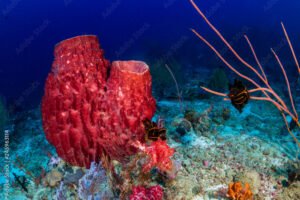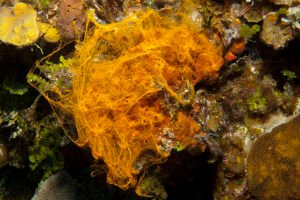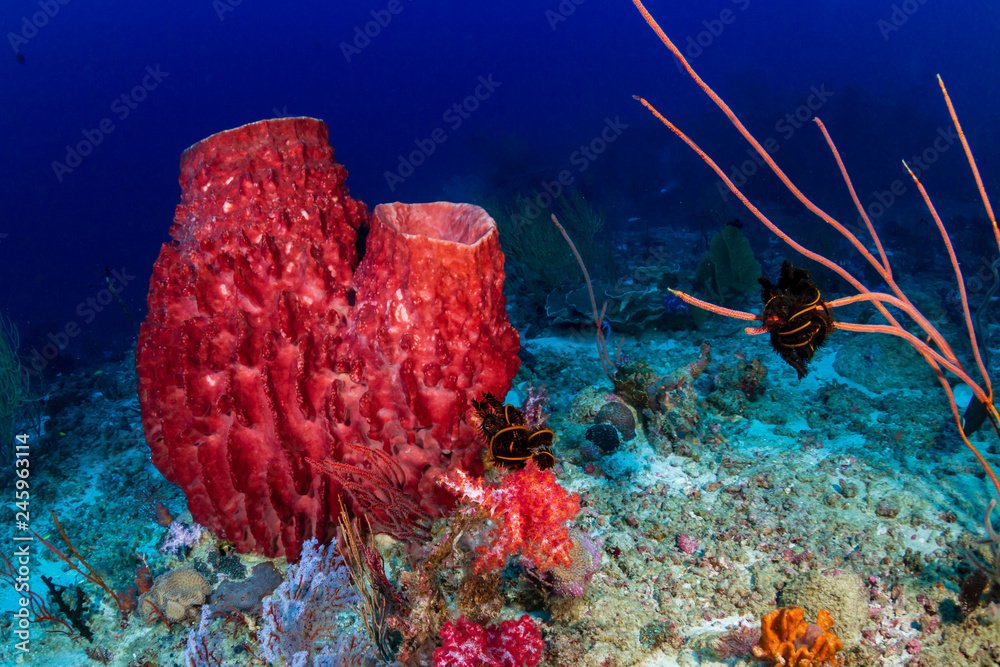Introduction to Sea Sponges
Sea sponges, scientifically known as Porifera, represent one of the most ancient and fundamental forms of life in marine ecosystems. These intriguing organisms have existed for over 600 million years, making them some of the oldest living creatures on the planet. Their simple yet highly effective biological structures have enabled them to thrive in diverse underwater environments, from shallow coastal waters to the deepest ocean trenches.
Biologically, sea sponges are categorized within the animal kingdom, despite their plant-like appearance. They are characterized by their porous bodies, which are composed of a network of tiny holes and channels. This unique anatomy facilitates the flow of water through their bodies, allowing them to filter nutrients and oxygen from their surroundings. The primary cell types that constitute the sponge’s structure include choanocytes, which are specialized for feeding, and amoebocytes, which play a crucial role in digestion, reproduction, and structural support.
Sea sponges are integral to marine ecosystems due to their ability to filter vast amounts of water, effectively cleaning their environment and providing a habitat for numerous marine organisms. Their presence contributes to the overall health and stability of coral reefs and other marine habitats. Additionally, they are involved in nutrient cycling, breaking down organic materials and releasing essential nutrients back into the ecosystem.
Their simple but efficient body plan and cellular functions have also made sea sponges a subject of interest in various scientific fields, including marine biology, ecology, and even biomedical research. Their unique properties, such as their ability to produce bioactive compounds, have potential applications in medicine and biotechnology.
Understanding the fundamental characteristics and ecological roles of sea sponges sets the stage for a deeper exploration of their diet, reproductive strategies, and the diverse varieties that populate the world’s oceans, which will be discussed in the forthcoming sections of this blog post.
The Feeding Habits of Sea Sponges
Sea sponges exhibit a unique and fascinating method of obtaining their food, primarily through a process known as filter feeding. Unlike more complex organisms, sponges lack a digestive system and instead rely on their porous bodies to draw in water. This process begins when water is channeled through the sponge’s tiny pores, called ostia, by the action of specialized cells known as choanocytes. These choanocytes possess flagella that create a constant flow of water, facilitating the movement of nutrients into the sponge’s internal cavity.
The primary diet of sea sponges consists of plankton, bacteria, and various organic particles suspended in the water. As water passes through the sponge’s internal canal system, these small food particles are trapped by the choanocytes and subsequently engulfed by the sponge’s cells. This efficient method of filter feeding allows sponges to extract necessary nutrients from their surrounding environment continuously.
Beyond their unique feeding habits, sea sponges play a crucial ecological role in nutrient cycling and water filtration within marine ecosystems. By filtering vast quantities of water, sponges help to maintain water clarity and quality, benefiting other marine organisms. Additionally, the nutrients they extract from the water are sometimes released back into the environment in different forms, contributing to the overall nutrient dynamics of the ecosystem.
The impact of sea sponges on their habitats cannot be overstated. Their ability to filter feed not only sustains their own nutritional needs but also supports the health and balance of marine ecosystems. As they process organic particles and bacteria, sponges help to reduce the load of potential pathogens and detritus in the water, thereby fostering a healthier environment for a diverse array of marine life.
In essence, sea sponges are not just passive inhabitants of the ocean floor; they are active participants in the complex web of marine life, contributing significantly to the maintenance and stability of their ecosystems through their feeding activities.
The Reproductive Strategies of Sea Sponges
Sea sponges exhibit a remarkable array of reproductive strategies that ensure their survival and proliferation in diverse marine environments. These fascinating organisms employ both sexual and asexual methods to reproduce, showcasing an impressive adaptability to their surroundings. Asexual reproduction in sea sponges can occur through budding and fragmentation. In budding, new sponges develop from the parent sponge, eventually detaching and becoming independent entities. Fragmentation, on the other hand, involves parts of the sponge breaking off, with each fragment capable of regenerating into a complete, functional sponge.
Sexual reproduction in sea sponges is equally intriguing. Sponges produce gametes—sperm and eggs—in a process that varies among species. Certain species release their gametes into the water column, where fertilization occurs externally, while others retain the eggs within their bodies, allowing internal fertilization. The resulting larvae are then released into the water, where they eventually settle and develop into adult sponges. This dual mode of reproduction, both asexual and sexual, provides sea sponges with a robust mechanism to thrive in variable marine conditions.
A particularly interesting aspect of sea sponge reproduction is hermaphroditism, where individuals possess both male and female reproductive organs. This characteristic enables a single sponge to produce both sperm and eggs, often at different times to avoid self-fertilization. Hermaphroditism in sponges enhances reproductive flexibility and success, especially in isolated environments where finding a mate could be challenging. Environmental factors such as water temperature, salinity, and availability of nutrients can significantly influence the reproductive cycles of sea sponges, triggering gamete production and release.
The reproductive strategies of sea sponges underline their evolutionary success and resilience. By leveraging both asexual and sexual reproduction, along with the ability to adapt to environmental changes, sea sponges exemplify the incredible diversity and complexity of life forms in the ocean. Their reproductive versatility not only ensures their survival but also contributes to the ecological balance within marine ecosystems.
Different Types of Sea Sponges
Sea sponges, known for their ecological significance and unique biological features, are categorized into four main classes based on their skeletal structures: Demospongiae, Calcarea, Hexactinellida, and Homoscleromorpha. Each class exhibits distinct characteristics and adaptive traits that allow them to thrive in diverse marine environments.
Demospongiae
Demospongiae, the largest class, encompasses around 90% of all sponge species. These sponges are primarily composed of spongin fibers and silica spicules, which provide structural support. Demospongiae species, such as the common bath sponge (Spongia officinalis), are found in various habitats ranging from shallow coastal waters to the deep sea. They exhibit a broad array of forms and colors, contributing significantly to marine biodiversity.
Calcarea
Calcarea, or calcareous sponges, possess skeletons made entirely of calcium carbonate spicules. These sponges are typically smaller and less diverse than Demospongiae, inhabiting primarily shallow, temperate, and tropical waters. An example of a Calcarea species is Sycon ciliatum, which resides in rocky coastal areas. The calcium carbonate structure of these sponges makes them easily recognizable and distinct from other classes.
Hexactinellida
Hexactinellida, commonly known as glass sponges, are renowned for their intricate silica-based skeletons, often resembling delicate glass structures. These sponges are predominantly found in deep-sea environments, where they form unique habitats on the ocean floor. The species Euplectella aspergillum, also known as the Venus flower basket, is a notable example, admired for its beautiful and complex lattice-like framework.
Homoscleromorpha
Homoscleromorpha is the smallest class of sea sponges, distinguished by their simple and uniform skeletons composed of siliceous spicules. These sponges are predominantly found in shallow marine environments, often in caves or under overhangs. Oscarella lobularis, a common species in this class, is known for its encrusting growth form and vibrant coloration.
The diverse types of sea sponges, each with their unique skeletal structures and habitats, play a crucial role in marine ecosystems. Their varied forms and functions contribute to the complexity and health of underwater environments, making them fascinating subjects of study in marine biology.
Ecological Significance of Sea Sponges
Sea sponges are pivotal to marine ecosystems, playing numerous critical roles that extend far beyond their unassuming appearance. One of their primary contributions is providing habitat for a diverse range of marine organisms. Sea sponges create complex structures that offer shelter and protection to smaller creatures such as crustaceans, mollusks, and various fish species. By doing so, they enhance the biodiversity of their surrounding environments.
Additionally, sea sponges contribute significantly to the structural complexity of coral reefs. Their intricate forms add to the physical architecture of these ecosystems, thereby promoting the stability and resilience of reef systems. This complexity is crucial for the survival of many marine species that rely on coral reefs for food, spawning grounds, and shelter.
Beyond their structural contributions, sea sponges play an essential role in biogeochemical cycles. They filter vast amounts of seawater, extracting and recycling nutrients, which helps maintain water clarity and quality. This filtration process also aids in the cycling of organic matter and the regulation of microbial populations, ensuring a balanced and healthy marine environment.
Moreover, sea sponges engage in various interactions with other marine species that are vital for ecosystem functioning. For instance, some sponges form symbiotic relationships with microorganisms such as bacteria and algae. These symbionts can provide the sponges with additional nutrients, while the sponges offer them a stable habitat. Such interactions exemplify the interconnectedness of marine life and highlight the integral role of sea sponges in sustaining ecological balance.
In summary, sea sponges are indispensable to marine ecosystems. They provide essential habitats, contribute to the structural integrity of coral reefs, and play a crucial role in nutrient cycling and water filtration. Their interactions with other marine species further underscore their ecological importance, making them key players in maintaining the health and diversity of oceanic environments.
Human Uses of Sea Sponges
Sea sponges have long captivated human interest due to their versatility and utility across various domains. Historically, they were prized for their absorbent properties, making them indispensable tools for personal care. In ancient Greece and Rome, natural sponges were used for bathing and cleaning. Their ability to retain water without dripping made them ideal for these purposes, a tradition that has persisted into modern times.
In the realm of personal care, natural sea sponges are favored for their softness and hypoallergenic properties. They are gentle on the skin, making them suitable for baby baths and facial cleansing routines. Unlike synthetic sponges, natural sea sponges contain enzymes that inhibit the growth of mold, mildew, and bacteria, thus ensuring a cleaner and longer-lasting product.
The medical field has also recognized the value of sea sponges. Historically, they were used in surgical procedures to absorb blood and other fluids. Modern medicine has adapted these practices, utilizing sea sponge-derived compounds in the development of antibiotics and other pharmaceuticals. These compounds have shown promise in combating antibiotic-resistant bacteria, highlighting the ongoing relevance of sea sponges in medical research.
Industrially, sea sponges have been employed in various applications due to their unique structural properties. They are used in the automotive and aerospace industries for cleaning and polishing delicate surfaces, given their non-abrasive nature. Artists also favor natural sponges for their texture, which allows for the creation of unique painting effects.
Despite their numerous benefits, the sustainability of harvesting natural sea sponges has raised environmental concerns. Overharvesting can lead to the depletion of sponge populations and disrupt marine ecosystems. Consequently, there has been a shift towards the development and use of synthetic sponges. While synthetic alternatives can reduce pressure on natural sponge populations, they often lack the biodegradability of their natural counterparts, posing a different set of environmental challenges.
Efforts to balance the human use of sea sponges with ecological sustainability are ongoing. Sustainable harvesting practices, such as rotational harvesting and aquaculture, aim to ensure that natural sponge populations remain viable. By adopting these methods, it is possible to continue benefiting from the myriad uses of sea sponges while minimizing their environmental impact.
Threats to Sea Sponge Populations
Sea sponges, integral components of marine ecosystems, face numerous threats that jeopardize their survival. One of the primary concerns is overharvesting. Sea sponges are collected for various purposes including natural bath products, medical research, and biochemical applications. Excessive harvesting can deplete local populations, causing significant ecological imbalances. Sustainable harvesting practices and regulations are essential to prevent overexploitation.
Pollution is another severe threat to sea sponges. Industrial waste, agricultural runoff, and plastic debris introduce harmful substances into marine environments. Chemical pollutants can impair the physiological functions of sea sponges, leading to decreased health and survival rates. Microplastics can also clog their filtration systems, disrupting their ability to feed and filter water, which is vital for their survival and the health of the surrounding marine ecosystem.
Climate change exacerbates the vulnerability of sea sponges. Rising ocean temperatures and ocean acidification affect the delicate balance of marine habitats. Warmer waters can lead to thermal stress, affecting the metabolic processes of sea sponges. Moreover, acidification of seawater can interfere with the formation of their skeletal structures, hindering growth and reproduction. These changes can have cascading effects on marine biodiversity and ecosystem stability.
Habitat destruction further endangers sea sponge populations. Coastal development, seabed trawling, and destructive fishing practices can physically damage or completely destroy the habitats where sea sponges thrive. The loss of these habitats not only reduces the available space for sea sponges to grow but also disrupts the intricate relationships they have with other marine species.
Conservation efforts are crucial to protect sea sponges and their habitats. Marine protected areas (MPAs) provide safe havens where sea sponges can flourish without human interference. Additionally, initiatives aimed at reducing pollution, mitigating climate change impacts, and promoting sustainable harvesting practices are essential. Understanding the importance of sea sponges in marine ecosystems underscores the necessity of these conservation measures to ensure their survival and the health of our oceans.
Future Research and Conservation of Sea Sponges
The study of sea sponges continues to reveal intricate details about their biology and ecological significance. Future research aims to dive deeper into the genetic makeup of these fascinating organisms, exploring their unique regenerative capabilities and potential applications in biotechnology and medicine. By employing advanced genomic techniques, scientists hope to unlock new insights into the evolutionary processes that have enabled sea sponges to thrive for millions of years.
One promising area of research focuses on the symbiotic relationships between sea sponges and various microorganisms. These associations play a crucial role in nutrient cycling and overall marine health, emphasizing the importance of understanding these complex interactions. Investigating the microbial communities associated with sea sponges could lead to discoveries of novel compounds with antibacterial, antiviral, and anticancer properties.
Conservation efforts are equally vital in ensuring the survival of sea sponge populations. As climate change and human activities continue to pose significant threats to marine environments, it is imperative to develop effective conservation strategies. International cooperation among scientists, policymakers, and conservationists is essential for the establishment of marine protected areas and the implementation of sustainable harvesting practices.
Moreover, there is a growing need for public awareness and education programs to highlight the ecological importance of sea sponges. By fostering a deeper understanding of their role in marine ecosystems, these initiatives can galvanize support for conservation efforts and promote responsible behavior among ocean users.
In conclusion, the future of sea sponge research and conservation holds immense promise. Through a combination of cutting-edge scientific exploration and robust conservation initiatives, we can ensure that these remarkable organisms continue to thrive, enriching our oceans and contributing to the broader understanding of marine biodiversity.
